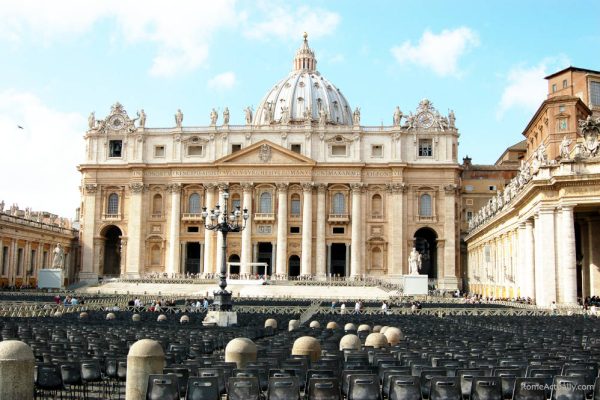Roman architecture and engineering feats are the most praised and copied around the world, both ancient and modern. Palaces built as a show of wealth and power by notable families, churches commissioned to leading architects to increase the prestige and authority of the clergy, as well as buildings aimed at public services such as streets, bridges, and aqueducts make some of the most famous buildings in Rome and attest to the level of civilization the city has reached throughout the centuries.
I have compiled this extensive but simple guide to the most important and scenic buildings of Rome so that I can guide you through its history and point out some worthy places many travelers go past without noticing.
Do you need some extra help deciding what to do in Rome?
Check out my custom Rome itineraries to build an unforgettable holiday!
What important buildings did the Romans build?
From the huge aqueducts to thermal baths to amphitheaters, there are many Roman buildings we can see across Europe to understand the level of sophistication of ancient Roman architects and engineers. Of course, the buildings of Rome we can visit today and that make the city so beautiful don’t belong only to ancient times but have been built across the centuries and that now are a fantastic example of different architectural styles such as Baroque and Renaissance.
That’s why our selection of the most representative buildings of Rome includes masterpieces belonging to every era from the BCs to the 20th century.
What buildings from ancient Rome still exist?
So many, from the important aqueducts to ancient Roman temples to early-Christian churches, most of the famous Roman buildings are still intact and fantastic sights to visit to learn more about this fascinating ancient civilization.
Why are Roman buildings still standing?
Good question. While the short answer would be because Capitalism didn’t exist yet, a longer answer is in order. Most of the Roman buildings that are not standing anymore are those that have been intentionally destroyed.
So what does the durability of the ancient Roman buildings depend on? A few features include brickwork, concrete, and the extensive use of arches. Even though borrowing precious architectural methods from other civilizations including the Greek one, the Romans added their own skills and created potentially eternal constructions.
Romans were also strong on the skills inherited by the former Etruscan population inhabiting central Italy which was the first to come up with a primordial idea of bridges, arches, and even aqueducts.
What are the most ancient buildings in Rome?
Some of the most ancient buildings in Rome include the Pantheon, the Colosseum, the Roman Forum and the Hadrian Mausoleum (Castel Sant’Angelo). But these really are the most famous and far from being the only ones.
What’s fascinating about exploring the eternal city is its multi-level layout. So while the above-mentioned are for sure worth a visit, below modern street level there are several Roman ancient buildings you should see if you wish to know more about Rome.
A great way to do so is to book an underground tour of Rome and see buildings such as the catacombs, parts of subterranean aqueducts as well as ancient houses (domus) and shops (insula).
22 Must-See Most Famous Buildings in Rome You Want to Visit
Pantheon
The Roman Pantheon is possibly the most famous domed building in Rome. Built by Marcus Vipsanius Agrippa, son-in-law of the emperor Augustus in 27 BC, it’s known as a temple devoted to all gods, but according to Roman historian Cassius Dio, the Pantheon was devoted to the gods of the Gens Julia (Julia dynasty).
For sure, it was built to celebrate the Gens Julia, one of the most powerful patrician families in ancient Rome that included notable members such as Julius Caesar and Augustus.

A truly impressive Roman building, the Pantheon boasted the largest dome in the ancient world and still now has one of the largest concrete domes in the world. Its dome has a hole known as “oculus” meant to ensure a direct connection with the divine.
Fully renovated by emperor Hadrian between 118 and 125 CE, in 609 CE it was donated by the Byzantine emperor Phocas to Pope Boniface IV who turned it into a Catholic church devoting it to the Virgin Mary with the title of Santa Maria ad Martyres.
Where: Piazza della Rotonda.
When: Every day 9 am-7 pm (last entrance 6 pm).
Colosseum
What’s the most famous among the ancient buildings in Rome? You guessed it, the Colosseum. A large amphitheater able to accommodate some 50.000 people, the Colosseum has an elliptical shape and measures 188 meters (roughly 617 feet) in length and 156 meters (roughly 512 feet) in width.
It is known also as Flavian Amphitheater (Amphitheatrum Flavium) because it was built by Emperor Titus Flavius Vespasianus between 70 and 81 CE.
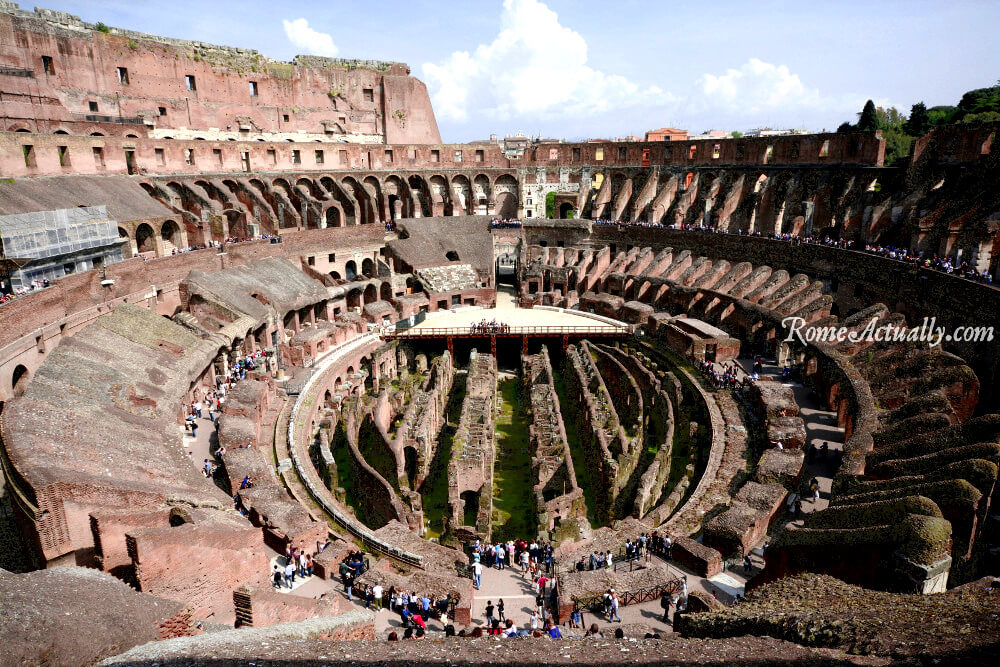
The place for the gory shows Romans loved so much, this is where gladiators would fight against each other and against wild animals. Visiting the Colosseum doesn’t only mean walking around its main bleachers but can involve also stepping on the arena where the shows took place and getting down to its dungeon where gladiators waited for their fate to evolve.
Where: Piazza del Colosseo.
When: Every day 8.30 am-7.15 pm (4.30 pm in winter).
For skip-the-line tickets, click here. If you are looking for a private guided visit, check out the best Colosseum tours here.
Castel Sant’Angelo
Built by Emperor Hadrian as his funerary monument (that’s why it’s also known as Hadrian Mausoleum), Castel Sant’Angelo fulfills its exclusive role as the emperor’s tomb until the beginning of the 5th century when emperor Honorius adds it inside the Aurelian Walls and gives the building a new purpose: stronghold of the city.
For centuries, many powerful Roman families contended over its use and possession until 1367, when Pope Urban V received its keys to officially put an end to the Avignon exile.
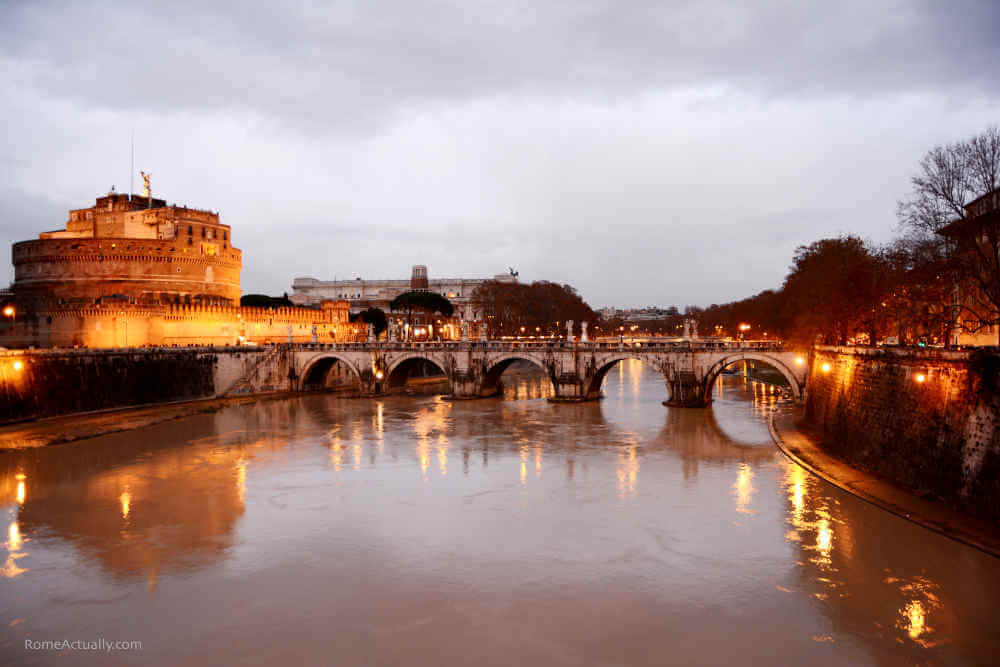
Visiting Castel Sant’Angelo inside somehow reveals how the history of the eternal city developed, and its main events, with the local notable clans and the clergy being at the center of how its society evolved. Plus, from its upper floor, you can enjoy a gorgeous view of St. Peter’s dome by Michelangelo. From a funerary monument to a defensive stronghold, from prison to residence, the history of Castel Sant’Angelo perfectly reflects the history of Rome.
The long and stormy past of Castel Sant’Angelo makes it one of the most fascinating as well as complicated buildings in Rome to fully grasp. This is why joining a tour led by a local guide will definitely add value to your experience. Check out this great private tour that will take you inside Castel Sant’Angelo by crossing the gorgeous Ponte Sant’Angelo bridge, a masterpiece of Gian Lorenzo Bernini.
Where: Lungotevere Castello 50.
When: Every day 9 am-7.30 pm (last entrance 6.30 pm)
You can book a reserved entrance here.
St. Peter’s Basilica
This is one of the most famous churches in Rome and one of the most important temples in Christendom. The Renaissance basilica we can visit today was built on top of the 4th-century Constantinian Basilica and of the ancient necropolis where is believed Saint Peter was buried.
From the necropolis all the way to Michelangelo’s cupola through the bronze canopy known as St. Peter’s Baldachin, all these masterpieces mark centuries of devotion built up on top of where first the Apostle founder of Christianity was buried in the 1st century.

Being a church, the entrance is free, but once inside, you are surrounded by such a huge wealth of artwork from mosaics to sculptures including La Pietà, one of the most famous statues in Rome, that you will feel as if being inside a museum. Your visit will be complete if you also climb the dome and enjoy the view of the spectacular St. Peter’s Square by Bernini and Rome city center.
Where: St. Peter’s Square.
When: Monday-Sunday 7 am-6.30 pm.
You can book a visit to the Basilica inclusive of dome climb here or check out the best Vatican tours for a more complete experience.
Vatican Palaces
The Apostolic Palace in the Vatican is home to some of the most important palaces and buildings in Rome including the famous Vatican Museums. From the 9th century, St. Peter’s Basilica was surrounded by a walled stronghold built upon the order of Pope Leo IV and gone down in history with the name of Leo’s City (Città Leonina).
Between the 13th and 14th centuries, more buildings were erected around a squared courtyard forming the first hub of what’s known as the Vatican Palaces. Some of the most famous highlights of the Apostolic Palace are the Sistine Chapel, Raphael’s Rooms, and the beautiful Vatican Gardens.
Where: Viale Vaticano.
When: Monday to Saturday 9 am-6 pm.
Teatro di Marcello
Slightly reminding of the Colosseum in shape, the construction of the Theater of Marcellus was started by Julius Caesar and finalized by Augustus and probably completed already in 17 BC. In 13 BC it was named after Marcellus as a tribute to Augustus’ nephew who died in Baiae in the Gulf of Naples in 27 BC.
The building was erected in the Campo Marzio area where traditionally theater plays took place and where since 179 BC there had been the “theatrum et proscenium ad Apollinis”, a theater close to the Apollo temple.
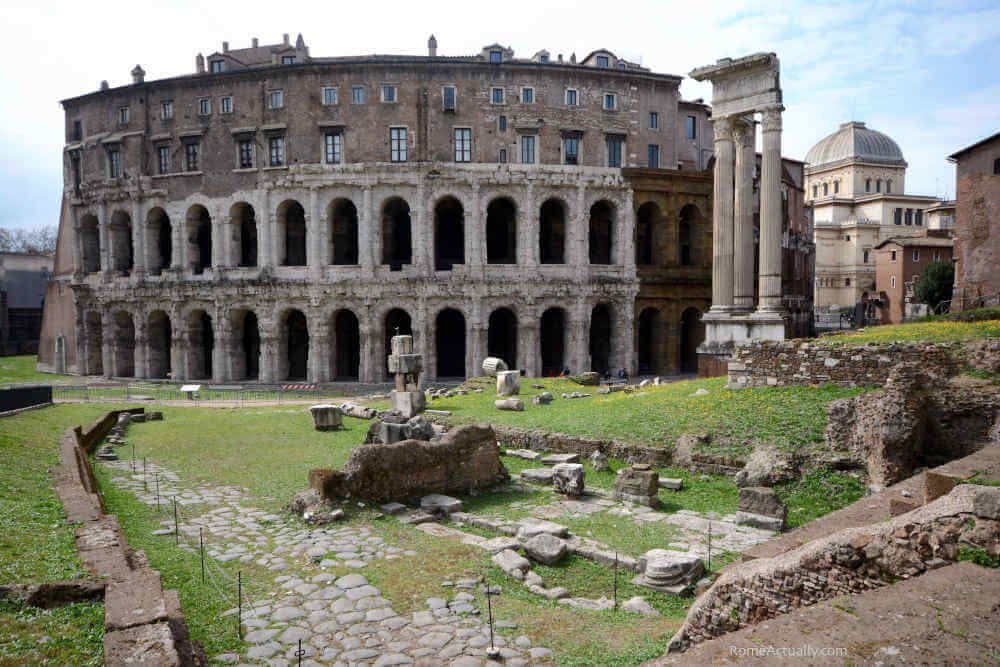
The Theater of Marcellus occupied an area of the former Circus Flaminius originally the place where peasants and ordinary citizens could participate in the “Concilia plebis”, important legislative and judiciary gatherings, and around which porticoes and temples were erected like in other peasant areas such as the Aventine Hill and the Forum Boarium.
Still in use until the 4th century, when Christianity took over the plays were suspended and the theater abandoned and used as a source of material for other buildings and a stronghold by patrician families. Today it’s possible to be visited only from outside.
Where: Via del Teatro di Marcello.
Make sure you don’t miss our selection of the best and most interesting ancient sites in Rome.
Mausoleum of Augustus
Less famous than the Colosseum, the Mausoleum of Augustus is another of the most impressive ancient buildings in Rome. Augustus started to envision his funerary monument already in 28 BC, only three years after the successful battle of Actium where his fleet won against Cleopatra of Egypt, finally ending the civil war between Octavianus and Marcus Aurelius and consecrating the future Augustus to rule what was the capital of the biggest empire of the time.
The Mausoleum of Augustus, round in shape similar to the Etruscan funerary buildings, and with a diameter of 87 meters (285 feet) is the world’s largest circular tomb. The urn accommodating the ashes of the emperor was likely placed in the center of the main body that was originally 40 meters tall (around 131 feet), while those of his relatives were inside a sepulchral cell on the side. Used as the family tomb for more than a century, when the Roman empire fell, the mausoleum was looted and used for other reasons, inevitably causing the loss of its aesthetic splendor.
Where: Piazza Augusto Imperatore.
When: Tuesday to Sunday 9 am-7 pm (until 4 pm in winter). Monday closed.
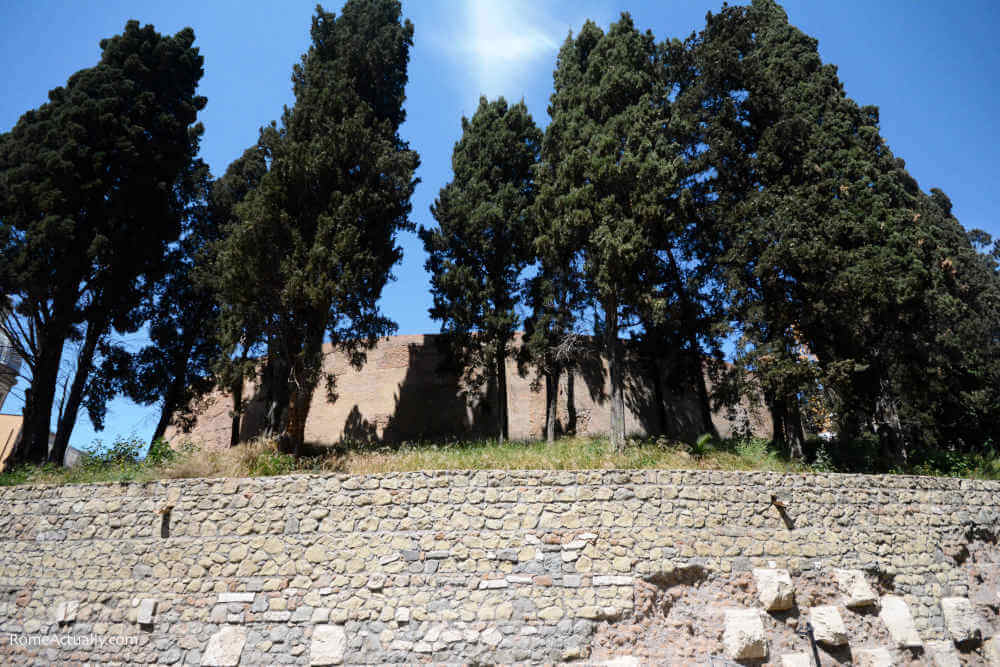
Ara Pacis
Today a museum arranging a beautiful and diverse selection of temporary exhibitions, the complex of the Ara Pacis is geographically and historically quite close to the Mausoleum of Augustus. Standing only 200 meters (650 feet) away from the imposing funerary monument, the Ara Pacis is one of the most sophisticated examples of classical art.
The Senate of Rome approved the building of an altar devoted to peace in 13 BC after Augustus’ endeavors north of the Alps between 16 and 13 BC where he strengthened the power of Rome and his own. The Ara Pacis was built in the northern part of Campo Marzio but because of the frequent floods of the Tiber river, it was gradually covered with dirt and forgotten. The decision for a complete restoration was taken during the Fascist rule in 1938 inside the pavilion in Via Ripetta.
Where: Lungotevere in Augusta.
When: Every day 9.30 am-7.30 pm.
Make sure you don’t miss our article on the birthday of Rome.
Palazzo dei Quirinale
Dominating the namesake Piazza del Quirinale, the palace today seat of the President of the Republic has been the residence of popes and later of the Italian royal family for some three centuries. Built on top of the Quirinale Hill, Rome’s tallest, the area has always been a favorite for official public palaces and sacred buildings.

The work of important architects such as Gian Lorenzo Bernini, Carlo Maderno and Domenico Fontana, inside, visitors can see one of the world’s largest art collections of paintings, sculptures, tapestry, porcelain, ancient watches and carriages. One of the highlights of the complex is the beautiful gardens of flowerbeds, hedges, and boulevards.
Where: Piazza del Quirinale.
When: Open Wednesday, Friday, Saturday and Sunday 9.30 am-4 pm. Mandatory booking here.
Vittoriano
A monument to the first king of Italy Vittorio Emanuele II, the Vittoriano, also known as the Altar of the Fatherland, hosts the museum of the Risorgimento, the series of battles that resulted in the national unification, and the tomb of the unknown soldier.
One of the iconic buildings of Rome symbol of majesty and power, the Vittoriano, because of its clash in color and style with the surrounding area and buildings, hasn’t always been welcomed by Romans who gave it a few monikers including typewriter and wedding cake.

Unfortunately, to build the Vittoriano, several medieval and Renaissance buildings and quarters were demolished such as the cloister of the beautiful church of Aracoeli. Today the highlights for visitors to admire within the Vittoriano complex include the rich museum, the fountains, the beautiful statues and the tomb of the unknown soldier placed below the statue of the Dea Roma goddess.
Where: Piazza Venezia.
When: Every day 9.30 am-7.30 pm.
Palazzo Barberini
Palazzo Barberini is an important notable palace in Rome formerly belonging to the powerful Barberini family. One of the first important projects commissioned to Bernini in Rome, the Barberini palace today is one of the seats of the Gallerie Nazionali di Arte Antica together with Galleria Orsini in Trastevere.
This is a Roman building designed by Carlo Maderno with the collaboration of Bernini and Borromini to renovate Villa Sforza bought by Pope Urban VIII Barberini in 1625.

Apart from its great architecture and design, visit Palazzo Barberini to see the masterpieces of some of the most famous Italian artists including Raphael, Caravaggio, Canaletto, Pietro da Cortona, Guido Reni and the same Bernini and Borromini.
Where: Via delle Quattro Fontane 13.
When: Tuesday-Sunday 10 am-6 pm (last entrance 5 pm). Monday closed.
Villa Farnesina
One of the places where to see Raphael’s work in Rome, visiting Villa Farnesina is one of the things to do in Trastevere. A beautiful work of the Italian Renaissance, Villa Farnesina was commissioned to architect Baldassarre Peruzzi in 1505 by the wealthy banker from Siena Agostino Chigi.
Patron and strong supporter of the arts, Agostino Chigi enjoyed his Roman life in the most exclusive social milieus of the city in the company of noble families and the clergy. The decoration inside the villa was commissioned to the leading artists of the Renaissance including Raphael who painted here his famous frescoes The Loggia of Cupid and Psyche and The Triumph of Galatea.
Where: Via della Lungara 230.
When: Every day 10 am-7 pm. Closed on Tuesday.
MAXXI
One of the most famous modern buildings in Rome is the MAXXI, Museo Nazionale delle Arti del XXI Secolo, the National Center for Contemporary Art and Architecture. The project for building the MAXXI was commissioned to the Anglo-Iraq architect Zaha Hadid. She, in fact, won the international competition launched by the Ministry for Cultural Heritage in 1998 among almost 300 candidates coming from all over the world. Hadid’s winning project is a futuristic building perfectly incorporating the local fabric even though with an innovative architectural style.
The MAXXI hosts a great variety of exhibitions including painting and photography with the most diverse range of subjects including historical documents, architecture, social issues, and even sci-fi.
Where: Via Guido Reni 4a.
When: Tuesday-Sunday 11 am-7 pm. Saturday and Sunday from 10 am, Monday closed.
Corte di Cassazione
Also called with the derogatory term “Palazzaccio” because very little appreciated by the Romans, the Italian Court of Justice (Corte Suprema di Cassazione) opens on the large Piazza Cavour on one side, with the entrance for the public, and on the Lungotevere and Ponte Umberto I on the other side, one of the most beautiful bridges in Rome.
Located in Prati, the latest Roman neighborhood to be built in the 19th century after the Italian unification, the palace was inaugurated in 1911.

Clearly inspired by Renaissance and Baroque patterns, this is one of the new buildings in Rome erected in the midst of the race to the urban development a new capital, the heart of the national institutions, deserved.
From Prati to the eclectic Esquilino to Castro Pretorio, the construction of new districts and new buildings was influenced by the Piedmontese style that we can see in the 19th-century architectural style in Turin.
Where: Piazza Cavour.
Pyramid of Caius Caestius
One of the hidden gems in Rome, the Pyramid of Caius Caestius, called in Italian Piramide Cestia, stands beside the Protestant Cemetery in the Testaccio neighborhood near Ostiense. After the conquest of Egypt in 31 BC and the death of Cleopatra, Romans started to be inspired by Egyptian art and culture.
This involved even funerary monuments like this one commissioned by the Roman politician Caius Caestius, a member of the Septemviri Epulones, judges in charge of organizing the feasts in honor of the gods.

Built between 18 and 12 BC, the Pyramid is almost 37 meters (121 feet) tall and each of its sides measures 30 meters (98 feet). One of the best-preserved ancient buildings in Rome, the exterior is covered with white marble slabs while the interior consists of a finely-frescoed barrel-vaulted burial chamber.
Where: Via Raffaele Persichetti.
When: Temporarily closed to the public, to visit you need to book via coopculture.it or calling +39 06 5743193 to book your spot in the guided tour every first weekend of the month.
Palazzo della Civiltà Italiana
Also known as the square Colosseum, Palazzo della Civiltà Italiana is one of the majestic modern buildings in Rome located in the recent EUR district and built under the Fascist rule between 1938 and 1940, when it was inaugurated even though still incomplete.
An imposing palace aimed at hosting the Museum of the Italian Civilization at the Esposizione Universale in 1942, the project wanted to prove the excellence of Italian architecture. Built in Neo-Classic and Fascist architectural styles, Palazzo della Civiltà Italiana is 68 meters (223 feet) tall and wants to remind the Colosseum through the rows of arched windows. From 2013, it’s the seat of the Italian designer Fendi.
Where: Quadrato della Concordia 5.
When: Monday to Friday 9 am-6 pm. Closed Saturday and Sunday.
Palazzo Montecitorio
Following a project by Gian Lorenzo Bernini, Palazzo Montecitorio is one of the buildings in Rome commissioned by Pope Innocent X Pamphilj to the great artist. Today the seat of the Parliament lower chamber, a few years after construction began, the pontiff died and works stopped to be resumed only 30 years later with Innocent XII.

Since in the meantime also Bernini had died, the project was commissioned to architect Carlo Fontana who appreciated the work his predecessor envisioned perfectly blending with the local urban fabric. Fontana did bring some changes, mainly adding elements to Bernini’s original project, such as the bell gable and two side doors.
Where: Piazza Monte Citorio.
When: Not open to the public for visits.
Roman Aqueducts
With traces visible in and around Rome as well as all over Italy and much of Europe, the aqueducts are possibly the most impressive achievement of Roman engineering. Using a sophisticated system of arches and inclination, the Romans reached perfection in the construction of such an important element of their civilization they exported wherever they conquered.

The ancient aqueducts in Rome were 11, to which were added five more during the Renaissance and modern times. Traces of the ancient water systems can be seen all across Rome, sometimes with ruins of old aqueducts overlapping, especially in the Parco degli Acquedotti south of Rome.
Other ruins can be found also in the Trevi area with the remains of the Aqua Virgo, in the Esquilino area and in Porta Maggiore, one of the gates of the Aurelian Walls.
Where: All over Rome, especially around Trevi and in the Parco degli Acquedotti.
Trajan’s Markets
A monumental ancient building in Rome, the Trajan’s Markets is a large complex that was used for offices and administrative purposes serving the adjacent Forum of Trajan. Built in layers and several floors, visiting its different areas it’s possible to see also ancient roads such as Via Biberatica and access the ruins of Trajan Forum itself.

Across the different floors, it’s the fantastic museum of the Imperial Fora that puts on display a huge collection of relics found in the ancient sites of the imperial fora of Caesar, Augustus, Nerva, Trajan and Tempio della Pace.
Where: Via Quattro Novembre 94.
When: Every day 9.30 am-7.30 pm.
The Baths of Caracalla
Alongside forums, markets and aqueducts, another important element of the Roman civilization was the building of thermal baths, several ruins of which we can see in Rome as well as around Roman colonies around Europe.

Together with those of Diocletian, the Baths of Caracalla were large and very luxurious. Within the complex it’s possible to visit the ground floor where were the main halls and areas of the baths, and also the undergrounds where is a Mithra temple, the library and where the slaves worked to burn the wood and keep the water warm.
Where: Viale delle Terme di Caracalla.
When: Tuesday to Sunday 9 am-7.15 pm (last entrance 6.30 pm). Monday closed.
Palazzo Farnese
Located right behind Campo de’ Fiori, Palazzo Farnese is today the seat of the French embassy and opens to visits only prior reservation and only with a certified guide from the embassy itself. The residence of the powerful Farnese family, Palazzo Farnese is one of the most important Roman buildings of the high Renaissance architectural style and one of the most beautiful palaces of the 16th century.
Its construction was commissioned to Antonio da Sangallo the Young by cardinal Alessandro Farnese, future Pope Paul III, in 1517. When Sangallo died, some of the biggest architects and artists of the time took over the works, from Michelangelo to Vignola to Giacomo della Porta who completed the masterpiece.
Where: Piazza Farnese.
When: Booking is mandatory through the French embassy in Rome.
Palazzo Mattei di Giove
Hosting the Library of Modern and Contemporary History, the Historic Institute for Modern and Contemporary Ages, and the National Musical Archives, Palazzo Mattei di Giove was built in 1598 by Carlo Maderno for the Marquis Giove Asdrubale Mattei married to the noblewoman Costanza Gonzaga.
Built over three levels, the palace mainly shows the features of late Renaissance architecture and is decorated with sculptures, bas-reliefs and ancient vases. The complex is a truly hidden gem in Rome and includes two courtyards, a monumental staircase and large halls with painted vaults.
Where: Via Michelangelo Caetani 32.
When: Booking is mandatory by calling +39 06 70454544 or emailing info@spazioliberocoop.it
Do you want to organize your own holiday but need some extra help?
Check out my complete course to plan your Rome trip with my guidance!

